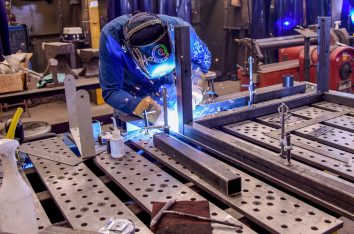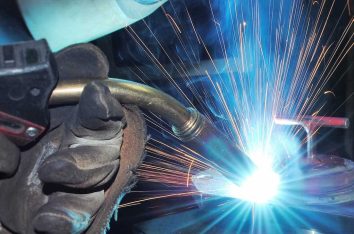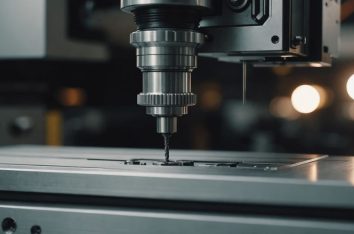In the ever-evolving manufacturing industry, welding remains a critical process that directly impacts productivity, quality, and cost-efficiency. With the advent of advanced welding techniques, manufacturers now have the opportunity to significantly enhance their welding processes. This article delves into various advanced welding techniques that can improve productivity and quality, offering manufacturers a competitive edge in the market.
Key Takeaways
- Advanced welding techniques can lead to significant productivity gains and cost savings.
- Robotic welding systems offer numerous benefits but come with implementation challenges.
- Laser and ultrasonic welding techniques provide high-quality welds suitable for various applications.
- Automation and process improvements are key to streamlining welding operations and boosting efficiency.
- Quality control and advanced materials play a crucial role in achieving optimal weld quality.
Robotic Welding Systems
Robotic welding systems offer an efficient solution for aerospace applications due to their advanced technology and automated capabilities. These automated welding systems not only increase productivity but also enhance weld quality control, ensuring the highest standards in aerospace welding. By utilizing robotic welding systems, manufacturers can achieve precise and consistent welds, reducing the risk of defects and improving overall product performance. These systems are equipped with advanced sensors and cameras that provide real-time feedback, allowing for immediate adjustments and corrections during the welding process. Additionally, robotic welding systems can handle complex welding tasks with ease, reducing the need for manual labor and minimizing human error. Overall, the efficiency of robotic welding systems makes them an ideal choice for aerospace applications.
Laser Welding Techniques
Laser welding is a high-precision welding technique that uses a laser beam to melt and fuse metals together. It is commonly used in the aerospace and medical device industries due to its ability to create clean, precise welds with minimal heat input. It is also one of the common techniques used for dissimilar welding, which requires expert skills to ensure a high-quality weld.
Advantages of Laser Welding
Laser welding offers numerous advantages over traditional welding methods. The use of a focused laser beam allows for a concentrated heat source, resulting in a smaller and more controlled weld zone. This advanced welding technology ensures uniform heat distribution and minimizes the risk of distortion or damage to the surrounding material. Additionally, laser welding is highly efficient and precise, making it ideal for applications requiring high-quality welds.
Applications of Laser Welding
Laser welding is widely used in various industries due to its precision and efficiency. In the aerospace industry, it is employed to join components with high integrity and minimal distortion. The medical device industry also benefits from laser welding, as it allows for the creation of clean and precise welds essential for medical instruments. Furthermore, laser welding is used in the automotive industry for repair and manufacturing processes, enhancing the overall quality and durability of the products.
Limitations of Laser Welding
Despite its many advantages, laser welding has some limitations. The initial setup cost for laser welding equipment can be high, making it less accessible for smaller businesses. Additionally, laser welding requires skilled operators to ensure optimal results, which can be a barrier for some companies. Another limitation is that laser welding may not be suitable for all materials, particularly those with high reflectivity or thermal conductivity. In such cases, alternative methods like electron beam welding may be more appropriate.
Ultrasonic Welding Methods
Ultrasonic welding is a solid-state welding process that uses high-frequency vibration energy to join materials. Unlike traditional welding methods, it does not melt the materials but brings them into a plastic state to form a bond. This technique is particularly effective for joining dissimilar materials and is widely used in various industries.
Ultrasonic welding is employed in numerous sectors due to its efficiency and reliability. Key industries include:
- Automotive: Used for wiring harnesses and interior components.
- Electronics: Ideal for circuit connections and micro-welding applications.
- Medical: Utilized in the assembly of medical devices and equipment.
- Aerospace: Ensures robust joints for critical components.
When compared to traditional welding methods, ultrasonic welding offers several advantages:
- Reduced Distortion: The process minimizes heat input, thereby reducing the risk of warping and distortion.
- Speed: Ultrasonic welding is faster, making it suitable for high-volume production.
- Energy Efficiency: It consumes less energy compared to conventional welding techniques.
- Versatility: Capable of joining a wide range of materials, including metals and plastics.
Streamlining the Welding Process
Streamlining the welding process is crucial for improving efficiency and reducing costs. This involves optimizing welding techniques, selecting the right welding equipment, and implementing quality control measures. By streamlining the process, manufacturers can reduce production time, minimize defects, and enhance overall product quality.
Analyzing Current Welding Processes
By analyzing the welding process, especially traditionally popular ones like SMAW welding and SAW welding, manufacturers can reduce the time and resources required to complete welding tasks, resulting in increased productivity. This involves a thorough examination of existing methods and identifying areas for improvement.
Implementing Process Improvements
Once the analysis is complete, the next step is to implement the necessary improvements. These may include adopting advanced techniques such as friction stir welding or beam welding, which offer higher efficiency and better quality. Additionally, integrating automation can further streamline operations, reducing manual labor and enhancing consistency.
Measuring Productivity Gains
To ensure that the implemented changes are effective, it is crucial to measure productivity gains. This can be done by tracking key performance indicators (KPIs) such as cycle times, output quality, and resource utilization. Regular monitoring and adjustments will help maintain optimal performance and continuous improvement.
Automation in Welding
Automation in welding has revolutionized the manufacturing industry by enhancing productivity and ensuring consistent weld quality. By integrating advanced technologies, welding processes can be streamlined, reducing the need for manual labor and minimizing human error. This section explores the various types of welding automation, the benefits it offers, and real-world case studies demonstrating its effectiveness.
Advanced Welding Materials
The field of advanced welding has seen significant innovations in recent years, particularly in the development of new materials that enhance the welding process. These innovations include the creation of high-performance alloys and the use of composite materials that offer superior mechanical properties. The introduction of these materials has revolutionized metal fabrication, making it possible to achieve stronger and more durable welds.
Ensuring material compatibility is crucial in advanced welding technologies. Different metals, such as aluminum, stainless steel, and steel, require specific welding techniques to achieve optimal results. The compatibility of the filler material with the base metal is also essential to prevent issues such as cracking and poor weld quality. Advanced welding processes often involve the use of specialized consumables and electrodes to ensure a high-quality weld.
The choice of welding materials has a direct impact on the quality of the weld. High-quality materials can significantly reduce defects and improve the overall strength and durability of the weld. For instance, using advanced alloys can enhance the mechanical properties of the weld, making it more resistant to stress and fatigue. Additionally, the use of innovative materials in cladding applications can provide superior protection against corrosion and wear, extending the lifespan of the welded components.
Quality Control in Advanced Welding
Quality control in advanced welding is essential to ensure that welded joints meet stringent specifications. Accuracy and consistency are paramount, especially in industries such as aerospace and automotive, where the reliability of welds is critical. Monitoring and inspection play a vital role in maintaining these standards.
Several techniques are employed to assure the quality of advanced welding processes:
- Visual Inspection: The first line of defense in quality control, visual inspection helps identify surface defects.
- Non-Destructive Testing (NDT): Methods such as ultrasonic testing, radiographic testing, and magnetic particle testing are used to detect internal flaws without damaging the weld.
- Destructive Testing: Techniques like tensile strength tests, bend tests, and impact tests are used to evaluate the mechanical properties of the weld.
- Process Monitoring: Continuous monitoring of welding parameters ensures that the process remains within specified limits.
Proper training is crucial for personnel involved in quality control. Training programs should cover:
- Understanding Welding Standards: Familiarity with industry standards and specifications.
- Inspection Techniques: Proficiency in both visual and non-destructive inspection methods.
- Use of Monitoring Equipment: Training on the use of advanced monitoring tools and equipment.
- Documentation and Reporting: Accurate documentation and reporting of inspection results are essential for traceability and accountability.
Enhanced Process Efficiency
To further optimize the welding process and improve overall efficiency, a combination of advanced techniques has been employed. These hybrid welding processes offer improved productivity and cost-effective techniques for the aerospace industry. Advanced processes offer increased arc and puddle control, making it easier for seasoned welders to do their jobs and enabling those less experienced to complete higher-quality welds than they might be able to otherwise.
Adoption of Advanced Welding Techniques
Some companies may be hesitant to try advanced welding processes, preferring to use conventional welding equipment providing traditional, short-arc processes. Why? Several reasons are possible. These include concerns about the initial investment, the need for specialized training, and potential disruptions to existing workflows. However, the benefits of an advanced welding arc can help smooth the transition, ultimately allowing companies to enter into new markets and grow their business.
Companies with advanced-class material and/or high-end manufacturing applications are most likely to embrace welding process advancements, which can have a significant impact on quality, consistency, and productivity. Because advanced welding processes introduce less heat into the workpiece, they help operators minimize distortion issues and spatter and reduce porosity. This leads to less rework and improved cycle times.
While these concerns must be carefully considered and addressed, the truth is that embracing advanced processes at the right time, for the right applications, can result in measurable benefits that justify the necessary training, potential changes to filler metals, or other adjustments. In fact, many companies today are turning to advanced welding processes to help increase plant capacity, often with less labor, and to expand their capabilities. This means they now can weld multiple part designs and use materials they may not be as familiar with.
Economic Impact of Advanced Welding
Advanced welding techniques have a significant economic impact on manufacturing industries. They enable the production of high-quality products at a lower cost, increasing competitiveness and profitability. Additionally, advanced welding techniques can reduce waste, energy consumption, and labor costs, leading to increased economic efficiency and sustainability.
Cost Savings
Advanced welding techniques can lead to significant cost savings for companies. By reducing the need for rework and minimizing material waste, businesses can lower their operational expenses. Additionally, advanced welding processes introduce less heat into the workpiece, which helps in reducing energy consumption and associated costs.
Return on Investment
Investing in advanced welding technologies can yield a high return on investment (ROI). Companies can increase their plant capacity and expand their capabilities without the need for additional labor or facilities. This allows businesses to enter new markets and grow their operations. The benefits of an advanced welding arc can help smooth the transition, ultimately allowing companies to enter into new markets and grow their business.
Market Competitiveness
Adopting advanced welding techniques can enhance a company's market competitiveness. By improving the quality and consistency of welds, businesses can meet higher industry standards and customer expectations. This can lead to increased customer satisfaction and loyalty, as well as a stronger market position. These trends emphasize the welding industry's sector-specific difficulties and opportunities, with transportation and manufacturing showing promise for growth.
Environmental Considerations in Welding
Environmental considerations are essential in welding, as the process can generate hazardous waste and emissions. Manufacturers must adopt eco-friendly practices, such as using clean energy sources, minimizing waste, and implementing recycling programs. By considering environmental impacts, manufacturers can reduce their carbon footprint and contribute to a more sustainable future.
Reducing Emissions
Welding processes can produce various emissions that may have negative health impacts on workers and the environment. Sustainability and green practices have become crucial considerations in the welding industry. By adopting advanced welding techniques, emissions can be significantly reduced, contributing to a cleaner and safer work environment.
Energy Efficiency
Energy efficiency is a key factor in modern welding processes. Innovations in welding technology contribute to building robust and environmentally conscious energy infrastructure. From traditional energy sources to renewable resources like wind turbines and solar panels, skilled welders are integral to shaping the energy landscape. Reducing the heat input during welding can lead to substantial energy savings and improved efficiency.
Sustainable Practices
Implementing sustainable practices in welding involves using eco-friendly materials and methods. This includes reducing waste, recycling materials, and minimizing the environmental footprint of welding operations. By focusing on sustainability, the welding industry can play a significant role in promoting environmental stewardship and reducing the overall impact on the planet.
Conclusion
In conclusion, the adoption of advanced welding techniques is essential for manufacturers aiming to enhance productivity and quality in their operations. By integrating methods such as robotic welding, laser brazing, and ultrasonic welding, companies can achieve superior joint integrity, strength, and durability. Additionally, streamlining traditional welding processes and investing in automation can significantly reduce manual labor and improve consistency. As materials and designs become more sophisticated, a precise understanding of welding techniques is crucial. With proper training, quality control measures, and regular maintenance, manufacturers can produce high-quality welds, reduce costs, and remain competitive in the industry.
Recent Posts
- CNC Machining in the Automation Industry: Precision Engineering for the Future
- CNC Machining in the Food Production Industry: Precision for Palates
- Welding and Fabrication in the Food Production Industry: Crafting Quality for Culinary Excellence
- What is Welding? An Introduction to Metal Joining Techniques
- How CNC Machining Works: The Technology Behind Precision Manufacturing




